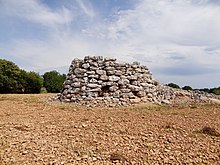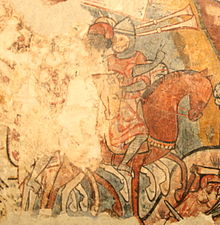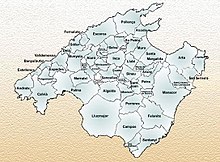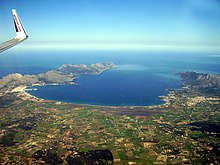Majorca
Mallorca is a Spanish island located in the central part of the Balearic archipelago, in the Mediterranean Sea. Its capital, and also that of the autonomous community of the Balearic Islands, is Palma de Mallorca, followed in importance by the municipalities of Calviá, Inca and Manacor. The island of Cabrera and all its islets administratively belong to the capital.
Majorca covers 3,640.11 km², making it the largest island in Spain and the seventh largest in the Mediterranean. Its 912,544 inhabitants (INE 2021) make it the most populous island in the Balearic archipelago and the second most populous in Spain after Tenerife. In addition, it is also the fourth most populous island in the Mediterranean Sea. Mallorca has a population density of 240.45 inhabitants/km². In the past, due to its calm atmosphere, it was also known as "The island of calm", but now it is a very important tourist destination, both nationally and internationally. Majorca has 550 km of coastline with more than 345 beaches of very varied type, from small stone coves to long sandy beaches.
Toponymy
Its name comes from the Latin insula maior, which means 'larger island', which would later derive in Maiorica, as opposed to Minorica or insula minor.
Geography
The Mallorcan relief is made up of the Sierra de Tramontana, with the highest mountains, the Sierra de Levante, with more modest heights, and other smaller mountains. The Tramontana mountain range, to the northwest, forms cliffs and rocky coves that contrast with the sandy beaches of the rest of the coastline.
El Llano is the fertile central plain. The island has a variety of caves, the best known being the Cuevas del Drach and Cuevas dels Hams. Both groups of caves are located in the coastal town of Porto Cristo and contain underground lakes that allow tourists to visit. To the west of this plain and in the center of the bay of Palma is the capital, Palma de Mallorca.
The main mountains are:
- Sierra de Tramontana: Puig Mayor (1445 m), Masanella (1364 m), Puig Tomir (1102 m), Puig de l'Ofre (1090 m), Puig del Teix (1064 m) and Puig de Galatzó (1027 m).
- Sierra de Levante: Puig de Morell (562 m), Bec de Ferrutx (519 m) and Puig de Sant Salvador (510 m).
- The Puig de Randa (543 m) and the Puig de Galdent (420 m) can be highlighted outside the two mountains.
History
The most primitive remains found in Mallorca date from 3500 BC. C. in the Neolithic era, a transition period between the Bronze Age, where the first copper objects appear. The first known settlers of the islands, (although of doubtful origin), were the Balearic slingers.
In the municipality of Calviá, in the town of Santa Ponsa, there is a small mountainous elevation called Puig de sa Morisca that has an archaeological park with remains of navetas and burial caves that covers an area of 35 hectares.
About 1300 B.C. C. experienced crucial changes that resulted in the emergence of the Talayotic culture. This warrior culture lasted after Quintus Cecilio Metellus (later to receive the nickname Balearicus ), invaded the island for the Roman Republic in the year 121 B.C. With the excuse of the frequent pirate incursions based on the islands, Rome decided to seize the archipelago, although the true intention of the invasion was to ensure its trade with the Phoenicians. Legend has it that the Roman general had to protect his boats with animal skins, because the slingers firing with their slings prevented them from disembarking. The Roman legions took two years to subdue the islands. After the conquest, the slingers became part of the Roman auxiliary troops, fighting prominently alongside Julius Caesar in the conquest of Gaul (the defensive armor was not very effective against the projectiles of the slingers). The Romans founded a castro on a rock at the mouth of the torrent now known as "sa Riera", approximately where the Almudaina palace stands today, which was the origin of the city of Palma.
In the year 425 Majorca was invaded and looted by the Vandals, a Germanic people who settled on the island until the year 534, when the Byzantine general Belisarius ordered the conquest of the Balearic archipelago.
In 707 the first recorded Muslim landing took place. Two centuries of permanent anxiety followed until, from the year 903, Mallorca fell into the hands of the Muslim Umayyad dynasty. The Occitan Romance is then replaced by Arabic. A flourishing period followed, during which Madina Mayurqa, today's Palma de Mallorca, was a great cultural center.
In 1115 a Pisan-Barcelona squadron attacked Majorca in a punitive expedition in retaliation for the piracy activities that were carried out from the island. Madina Mayurqa was sacked and destroyed for the first time, and in the absence of Ramón Berenguer III, his men and allies fled when they sighted an Almoravid squad that was sent from Africa to confront them. The island was left in the hands of an Almoravid family, the Banu Ganiya. Later, in 1203, the Almohads seized Majorca. In 1208, the Almohads appointed Abu Yahya governor, who formed a semi-independent principality, with only formal submission to the Almohad emir.
The troops of the Crown of Aragon led by James I the Conqueror, who arrived on the island from Salou in 1229, definitively conquered the island for the Christians. After definitively defeating Abú Yahya in the battle of Portopí (1229) and taking Madina Mayurqa (1230), the resistance ceased in 1231, except for the castle of Alaró, which resisted for eight years and was the last refuge of Muslim resistance. during the Christian conquest. Jaime I created in his will the kingdom of Majorca comprising not only Majorca, but the rest of the Balearic Islands —Menorca (still under the power of a Muslim sovereign, although tributary since 1231), Ibiza and Formentera—; the counties of Roussillon and Cerdanya; and the territories that Jaime I kept in Occitania (the lordship of Montpellier, the vizcounty of Carladés and the barony of Omeladés). On his death (1276), his son Jaime II of Mallorca assumed the throne after the oath of the so-called Charter of Franchises. The independence of the kingdom was short. In 1349 he was reincorporated into the Crown of Aragon. The death of King Jaime III of Mallorca in the battle of Lluchmayor was the end of the Kingdom of Mallorca. Although until his death in 1404 his daughter Isabel, established in the castle of Gallargues near Montpellier, which was granted to her by the King of France Carlos VI, proclaimed herself Queen of Majorca.
In the time of Carlos I, in 1521, there was an uprising similar to that of the brotherhoods of the kingdom of Valencia (insurrection of the forans), the rebels came to surround the town of Alcudia, where the nobility of the island had taken refuge. Throughout the XVI century, the island, like the rest of the Balearic Islands and the Spanish Levant, suffered attacks and looting of the Turkish and Barbary pirates. During the War of the Spanish Succession, the island opted for Archduke Carlos of Austria, against Felipe de Anjou.
Climate
The Majorcan climate is typically Mediterranean, with high temperatures in summer (over 30 °C) and moderately low temperatures in winter (rarely below 5 °C). Snowfalls are common in winter on the highest peaks of the Sierra de Tramuntana but exceptional on the plains and the capital. Being an island, the humidity level is very high.
| Month | Ene. | Feb. | Mar. | Open up. | May. | Jun. | Jul. | Ago. | Sep. | Oct. | Nov. | Dec. | Annual |
|---|---|---|---|---|---|---|---|---|---|---|---|---|---|
| Average temperature (°C) | 15.4 | 15.5 | 17.2 | 19.2 | 22.5 | 26.5 | 30.4 | 29.8 | 27.1 | 23.7 | 19.3 | 16.5 | 21.8 |
| Average temperature (°C) | 11.9 | 11.9 | 13.4 | 15.5 | 18.8 | 22.7 | 25.7 | 26.2 | 23.5 | 20.2 | 15.8 | 13.1 | 18.2 |
| Temp. medium (°C) | 8.3 | 8.4 | 9.6 | 11.7 | 15.1 | 18.9 | 21.9 | 22.5 | 19.9 | 16.6 | 12.3 | 9.7 | 14.6 |
| Total precipitation (mm) | 43 | 37 | 28 | 39 | 36 | 11 | 6 | 22 | 52 | 69 | 59 | 48 | 449 |
| Precipitation days (≥ 1 mm) | 6 | 6 | 5 | 5 | 4 | 2 | 1 | 2 | 5 | 7 | 6 | 7 | 53 |
| Hours of sun | 167. | 170 | 205 | 237 | 284 | 315 | 346 | 316 | 227 | 205 | 161 | 151 | 2779 |
| Source: State Meteorology Agency | |||||||||||||
Political organization
Mallorca's highest political institution is the Island Council of Mallorca. This body is in charge of policies that affect the island as a whole. It should also be noted that the headquarters of the Government of the Balearic Islands, the archipelago's highest institution, is located in Palma.
Municipalities
Country
The regions of Mallorca do not have administrative recognition, but there is a consensus among geographers about them.
- The capital: Palma de Mallorca
- Plano de Mallorca
- Sierra de Tramontana
- Raiguer
- Migjorn
- Levante
Demographics
Mallorca is the most populated island in the Balearic archipelago and the second most populous island in Spain, after Tenerife, in the Canary Islands, and is also the fourth most populous island in the Mediterranean. It has a registered population of 896,038 inhabitants (2019), of which slightly less than half live in its capital, Palma de Mallorca (416,065) (January 1, 2019). The municipalities that follow it in population are Calviá (50,363), Manacor (40,264), Marrachí (35,521), Lluchmayor (34,602), Inca (30,625), Alcudia (19,768), Felanich (17,291) and Pollensa (16,088) (INE data, January 1, 2014).
The metropolitan area of Palma de Mallorca, which spans the municipalities of Palma de Mallorca, Calviá, Marrachí and Lluchmayor, located in the Bay of Palma, has more than 550,000 inhabitants. On the contrary, the least populated municipality is that of Escorca (241) located in the Sierra de Tramontana.
Mallorca receives about 16.5 million visitors a year mainly due to tourism, which is the most important activity on the island. This influx of visitors makes the population of the cities multiply in summer. The presence of a high number of resident foreigners is noteworthy.
Languages
Catalan, in its dialect variety called Mallorcan, is the language of Mallorca and is co-official along with Spanish. The Catalan language arrived on the island with the conquest of Mallorca by James I, on December 31, 1229, and spread thanks to the farmers of Ampurdán and Roussillon who repopulated it from the year 1236.
Majorcan Catalan is part of the eastern block, specifically the Balearic dialect (or insular Catalan) and the Majorcan subdialect. There are some local forms with quite a marked personality, such as the Mallorcan Pollencino and the Mallorcan Sollerico.
Economy
The two main engines of the economy are tourism and construction, having relegated industry (leather, footwear, furniture, ceramics, pearls, jewelry, costume jewelery) and the primary sector (agriculture, livestock, fishing, mining), although local administrations have recently made an effort to diversify the Mallorcan economy by promoting other sectors. In this sense, the Majorcan hospitality and nautical industries are among the first in Spain and even in the world. The towns that concentrate the largest number of tourists are found in the municipality of Calviá (the region of the area), specifically in the tourist town of Magaluf, followed by part of the Palma de Mallorca beach known as El Arenal and the area of Alcudia. In 2008, many of the old Mallorcan estates have been converted into rural tourism hotel establishments, as is the case of Son Boronat (where you can see a system of Arab canals and the real defense tower of the estate, dating from the 18th century). XIV), although many others, such as La Porraza, continue with a small agricultural activity and as a mansion for their owners.
One of the bays of the island with some international renown, consists of Portals Vells with the cove of El Mago which owes its name to a movie that was filmed there in 1967 with Anthony Quinn, Candice Bergen and Michael Caine as protagonists. At first the film was to be shot in Greece, but the coup d'état that took place there caused the production company to change the setting and the new place chosen was Mallorca. Film critics raved about the beautiful spot in the Aegean, until a Mallorcan emigrant wrote to the publications to prove that it was actually a Mallorcan beach and not a place in Greece.
Agriculture
- Livestock
In one of the descriptions of Arab Majorca carried out in the XII century by Al-Zuhri, he already highlighted the island's livestock, especially sheep, but also cows, bulls and mules. cattle in some possessions of the Sierra Norte of the island, whose morphological characteristics differed from the rest of the usual cattle found in conventional farms. Due to this, in 1980 a search began that started from the "L' ofre", where there were about 15 females that they did not want to part with. Shortly after, a collaboration began between landowners who owned some specimens, but they encountered the problem that they could not find a single bull of this breed in the entire the island, since the last Well, he had been dead for two years. Its owner, the owner of L & # 39; Ofre, commented that he had bought it in Felanich in 1965.
Tourism
- Visits by country of origin
Data taken from the Statistical Institute of the Balearic Islands
| Rank | Country or territory | 2014 | 2015 | 2016 | 2017 |
|---|---|---|---|---|---|
| 1 | Germany | 3.710.313 | 3.450.687 | 3.308.604 | 2.224.709 |
| 2 | United Kingdom | 2.105.981 | 1.986.354 | 1.898.838 | 1.324.294 |
| 3 | national | 985.557 | 1.192.033 | 1.195.822 | 759.825 |
| 4 | Nordic countries | 758.637 | 668.328 | 572.041 | 387.875 |
| 5 | Benelux | 363.911 | 360.973 | 368.930 | 284.845 |
| 6 | France | 337.891 | 349.712 | 316.124 | 187.589 |
| 7 | Switzerland | 312.491 | 292,226 | 280.401 | 188.826 |
| 8 | Austria | 160.890 | 138.287 | 181.993 | 107.991 |
| 9 | Italy | 154.227 | 173.680 | 200.851 | 135.535 |
| 10 | Ireland | 104.827 | 115.164 | 158.646 | 68.456 |
Communications
The main way to get to Mallorca is by plane. From Palma airport there are regular flights with the capitals of the other islands (Ibiza and Menorca), some mainland cities (Barcelona, Valencia, Madrid, Alicante and Bilbao) and with many European cities, mainly the United Kingdom and Germany. Palma de Mallorca airport is the 3rd in Spain in terms of passenger traffic.
In addition to the international airport, there is also the small Son Bonet aerodrome used for light aircraft, small private planes and helicopters. To the east is the base for the island's fire-fighting aerial resources (planes and helicopters).
In addition to the plane, it is also possible to travel by boat to Valencia or Denia from the port of Palma and to Barcelona, from the port of Palma de Mallorca and Alcudia. The boat allows travel by car. Ship and plane are the means of interconnection between the islands.
Mallorca has an extensive road network. Between the years 1965 and 2000, a series of highways were built that communicated the capital with the main towns and regions of the island. In addition, it has numerous secondary roads for interregional and local connections.
Railway
The island has two railway networks:
- The main network, operated today by the public company Servicios Ferroviarios de Mallorca (SFM) has assumed a resurgence in the old railway network exploited by Feve until 1994, which was in its day about to disappear. The repeated requests of the Malloquin citizens to the authorities made it possible to re-engage firmly with rail transport. Since then the Palma-Enllaç stretch has been electrified and until 2011 it was worked on the progressive reopening of closed branches in the second half of the centuryXX.. SFM also manages the Palma de Mallorca metro, opened in 2007 and connects the city center with the University of the Balearic Islands and Marrachí.
- The Sóller railway was built in 1912 and is a tourist attraction. Connect the center of Palma with the municipality of Sóller.
Mallorca together with Tenerife are the only Spanish island territories that have interurban railways.
Architecture
- One of the most representative architectural figures on the island, consists of the castle of Bellver, being one of the four only European castles of circular plant.
- The Cathedral of Santa Maria de Palma, famous for containing one of the largest rosettes in the Gothic style of Levantino, becoming known as the Gothic eye.
- La Almudaina, the Royal Alcazar of Palma de Mallorca.
- The monastery of Lluc, a place of pilgrimage par excellence of the island, for the Virgin of Lluc (Patrona de Mallorca).
- The Calviá promenade considered the green lung of the municipality, with a journey of 32 kilometers.
- The castle of Bendinat built in the centuryXIX for the Marquis de la Romana.
Gastronomy
One of the most popular dishes is the Mallorcan frit (frit mallorquí), which consists of fried liver with French fries and peppers; It can be blood and/or offal of lamb, pork and sea fennel. Another option is also the sailor, which has a mixture of fish cut into small pieces that are also accompanied by fried potatoes and sea fennel. Mention should also be made of escaldums or guisat de piletes, Majorcan soups, tumbet, with or without esclatasang (tastier variety of rovellón found in the Iberian Peninsula), and stuffed aubergines. There are several ways to prepare rice, the most typical is the so-called arròs brut, which consists of soupy rice with mushrooms, snails, pork, rabbit and poultry meat, and vegetables, although it is also very traditional arroç sec, very similar to paella. The pa amb oli, typical of some dinners or as a simple accompaniment to other meals, is one of the most traditional dishes on the island. Sausages are also one of the main elements of its gastronomy; sobrasada, llonganissa, butifarrón, camaiot and blanquet, among others.
In meals and generally family gatherings, it is typical to make roast pork, with chopped potatoes and seasoned with herbs from the island, such as rosemary. Escaldums are also typical, a kind of stew with pieces of turkey —and sometimes chicken— with potatoes and meatballs.
The salad that is usually eaten in summer is known as trempó and is made with tomato, onion and white pepper (a variety of green pepper from the islands).
Many meals are accompanied by Majorcan bread (brown or white, although always without salt) or "quelitas" type cookies (oil biscuits typical of the island). Brown bread is the most appreciated in the Palma area and white bread in the Llano de Mallorca.
- Pastries and pastries
The quintessential sweet is the ensaimada which is usually eaten for breakfast, but which is also made in family sizes filled with cream, angel hair, chocolate or with pieces of sobrasada and candied pumpkin. During Holy Week, empanadas, stuffed with lamb, are essential. They can be made of sweet or salty pasta, although those of salty pasta are more common. Also typical are crespells and robiols, traditionally filled with cottage cheese, angel hair and jam. The so-called vegetable coca is also very common, that of trempó or roasted red peppers, together with the cocarrois, which are a kind of empanadas of Arab origin in the shape of crescent stuffed with vegetables and raisins. The spines are also typical.
Mallorcan wines have been well received in other parts of Spain and Europe in recent years. Mallorca has two denominations of origin: “D.O. Binissalem-Mallorca" and "D.O. Pla y Levante», as well as with a geographical indication Vino de la Tierra Mallorca.
Parties
On January 20, Palma de Mallorca celebrates its patron saint, San Sebastián, although above all its revetlla or evening, the day before, but in most towns on the island, the The most celebrated festival is San Antonio Abad (January 17) and the eve of San Antonio (January 16) celebrated in many towns (Artá, Manacor, etc.) but par excellence in La Puebla, where it has been celebrated since the 18th century. XIII, year after year, being one of the most important festivals on the entire island. Another of the massive festivals on the island is the Dijous Bo ('Good Thursday') in Inca, a fair with all kinds of Majorcan products, and which is a holiday in some towns in the center of the island (the "Raiger"). And commemorating the fight against Muslims, there are several places where there is a tradition of staging battles between Christians and Muslims. The places where people live with the most passion —called “Moors and Christians”— are Pollensa, celebrated on the day of “the Patron Saint» (August 2), and Sóller, the Monday after the second Sunday in May.
The oldest festival celebrated in Mallorca (and one of the oldest in Europe, since it has been taking place uninterruptedly since 1229) is the one that every December 31st commemorates the conquest of the Crown of Aragon in the Capital by the troops of King James I.
Every year on the first Saturday of August, the Marcha des Güell a Lluc a peu is celebrated, which walks up from Palma de Mallorca and other towns to the Monastery of Lluc (Escorca). In this march, the faithful go to venerate Our Lady of Lluc (Patroness of Mallorca).
The Diada de Mallorca is also celebrated on September 12, a festival recently established by the Island Council of Mallorca in which the oath taken by King James II of Mallorca in the year 1276 of the Carta de franceses i privilegis del Regne de Mallorca. Also on this day, but in 1229, according to tradition, the Christian troops commanded by Jaime I, disembarked in Santa Ponsa and began the conquest of Mallorca.
As for local festivities, the patron saint of the capital Palma stands out (San Sebastián, January 20), on the eve of which bonfires are lit through the streets of the city and torrades are practiced. (barbecue) of local sausages: sobrasada, butifarrón, etc.
Famous Mallorcans
Contenido relacionado
Banff National Park
Annex: Municipalities of the province of Palencia
Kitamoto (Saitama)


















